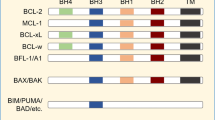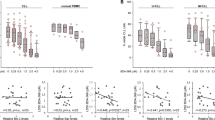Abstract
New agents are required for the treatment of chronic lymphocytic leukaemia (CLL). We show here that a protein kinase C inhibitor, bisindolylmaleimide IX, is a potent inducer of apoptosis in CLL cells, and investigate the mechanisms by which this is induced. Bisindolylmaleimide IX induced a conformational change and subcellular redistribution of Bax from the cytosol to the mitochondria, resulting in the release of the proapoptotic mediators cytochrome c, Smac and Omi/HtrA2 from the mitochondrial inner membrane space. This was followed by the activation of caspase-9 as the apical caspase and subsequent activation of effector caspases. CLL cells undergoing apoptosis showed a rapid caspase-mediated cleavage of Mcl-1, an antiapoptotic member of the Bcl-2 family implicated in CLL survival and poor prognosis. This cleavage was mediated primarily by caspase-3. Cleavage of Mcl-1 may provide a feed-forward amplification loop, resulting in the rapid induction of apoptosis. Bisindolylmaleimide IX or a related derivative may be of clinical use in the treatment of CLL.
This is a preview of subscription content, access via your institution
Access options
Subscribe to this journal
Receive 12 print issues and online access
$259.00 per year
only $21.58 per issue
Buy this article
- Purchase on Springer Link
- Instant access to full article PDF
Prices may be subject to local taxes which are calculated during checkout








Similar content being viewed by others
References
Reed JC . Molecular biology of chronic lymphocytic leukemia: implications for therapy. Semin Hematol 1998; 35: 3–13.
Bannerji R, Byrd JC . Update on the biology of chronic lymphocytic leukemia. Curr Opin Oncol 2000; 12: 22–29.
Ashkenazi A, Dixit VM . Death receptors: signaling and modulation. Science 1998; 281: 1305–1308.
Bratton SB, MacFarlane M, Cain K, Cohen GM . Protein complexes activate distinct caspase cascades in death receptor and stress-induced apoptosis. Exp Cell Res 2000; 256: 27–33.
Cohen GM . Caspases: the executioners of apoptosis. Biochem J 1997; 326: 1–16.
Bratton SB, Cohen GM . Apoptotic death sensor: an organelle's alter ego? Trends Pharmacol Sci 2001; 22: 306–315.
Almond JB, Cohen GM . The proteasome: a novel target for cancer chemotherapy. Leukemia 2002; 16: 433–443.
MacFarlane M, Harper N, Snowden RT, Dyer MJ, Barnett GA, Pringle JH et al. Mechanisms of resistance to TRAIL-induced apoptosis in primary B cell chronic lymphocytic leukaemia. Oncogene 2002; 21: 6809–6818.
McConkey DJ, Chandra J, Wright S, Plunkett W, McDonnell TJ, Reed JC et al. Apoptosis sensitivity in chronic lymphocytic leukemia is determined by endogenous endonuclease content and relative expression of BCL-2 and BAX. J Immunol 1996; 156: 2624–2630.
Pepper C, Hoy T, Bentley P . Elevated Bcl-2/Bax are a consistent feature of apoptosis resistance in B-cell chronic lymphocytic leukaemia and are correlated with in vivo chemoresistance. Leuk Lymphoma 1998; 28: 355–361.
Kitada S, Andersen J, Akar S, Zapata JM, Takayama S, Krajewski S et al. Expression of apoptosis-regulating proteins in chronic lymphocytic leukemia: correlations with in vitro and in vivo chemoresponses. Blood 1998; 91: 3379–3389.
Kaufmann SH, Karp JE, Svingen PA, Krajewski S, Burke PJ, Gore SD et al. Elevated expression of the apoptotic regulator Mcl-1 at the time of leukemic relapse. Blood 1998; 91: 991–1000.
Pedersen IM, Kitada S, Leoni LM, Zapata JM, Karras JG, Tsukada N et al. Protection of CLL B cells by a follicular dendritic cell line is dependent on induction of Mcl-1. Blood 2002; 100: 1795–1801.
Gescher A . Staurosporine analogues – pharmacological toys or useful antitumour agents? Crit Rev Oncol Hematol 2000; 34: 127–135.
Way KJ, Chou E, King GL . Identification of PKC-isoform-specific biological actions using pharmacological approaches. Trends Pharmacol Sci 2000; 21: 181–187.
Byrd JC, Shinn C, Willis CR, Flinn IW, Lehman T, Sausville E et al. UCN-01 induces cytotoxicity toward human CLL cells through a p53-independent mechanism. Exp Hematol 2001; 29: 703–708.
Ganeshaguru K, Wickremasinghe RG, Jones DT, Gordon M, Hart SM, Virchis AE et al. Actions of the selective protein kinase C inhibitor PKC412 on B-chronic lymphocytic leukemia cells in vitro. Haematologica 2002; 87: 167–176.
Zhou T, Song L, Yang P, Wang Z, Lui D, Jope RS . Bisindolylmaleimide VIII facilitates Fas-mediated apoptosis and inhibits T cell-mediated autoimmune diseases. Nat Med 1999; 5: 42–48.
Almond JB, Snowden RT, Hunter A, Dinsdale D, Cain K, Cohen GM . Proteasome inhibitor-induced apoptosis of B-chronic lymphocytic leukaemia cells involves cytochrome c release and caspase activation, accompanied by formation of an approximately 700 kDa Apaf-1 containing apoptosome complex. Leukemia 2001; 15: 1388–1397.
Sun XM, Bratton SB, Butterworth M, MacFarlane M, Cohen GM . Bcl-2 and Bcl-xL inhibit CD95-mediated apoptosis by preventing mitochondrial release of Smac/DIABLO and subsequent inactivation of X-linked inhibitor-of-apoptosis protein. J Biol Chem 2002; 277: 11345–11351.
Dewson G, Snowden RT, Almond JB, Dyer MJ, Cohen GM . Conformational change and mitochondrial translocation of Bax accompany proteasome inhibitor-induced apoptosis of chronic lymphocytic leukemic cells. Oncogene 2003; 22: 2643–2654.
Bratton SB, Walker G, Roberts DL, Cain K, Cohen GM . Caspase-3 cleaves Apaf-1 into an approximately 30 kDa fragment that associates with an inappropriately oligomerized and biologically inactive approximately 1.4 MDa apoptosome complex. Cell Death Differ 2001; 8: 425–433.
Scaffidi C, Medema JP, Krammer PH, Peter ME . FLICE is predominantly expressed as two functionally active isoforms, caspase-8/a and caspase-8/b. J Biol Chem 1997; 272: 26953–26958.
Srinivasula SM, Ahmad M, Fernandes-Alnemri T, Alnemri ES . Autoactivation of procaspase-9 by Apaf-1-mediated oligomerization. Mol Cell 1998; 1: 949–957.
Bratton SB, Walker G, Srinivasula SM, Sun XM, Butterworth M, Alnemri ES et al. Recruitment, activation and retention of caspases-9 and -3 by Apaf-1 apoptosome and associated XIAP complexes. EMBO J 2001; 20: 998–1009.
Kluck RM, Bossy-Wetzel E, Green DR, Newmeyer DD . The release of cytochrome c from mitochondria: a primary site for Bcl-2 regulation of apoptosis. Science 1997; 275: 1132–1136.
Desagher S, Martinou JC . Mitochondria as the central control point of apoptosis. Trends Cell Biol 2000; 10: 369–377.
Martinou JC, Green DR . Breaking the mitochondrial barrier. Nat Rev Mol Cell Biol 2001; 2: 63–67.
Verhagen AM, Ekert PG, Pakusch M, Silke J, Connolly LM, Reid GE et al. Identification of DIABLO, a mammalian protein that promotes apoptosis by binding to and antagonizing IAP proteins. Cell 2000; 102: 43–53.
Du C, Fang M, Li Y, Li L, Wang X . Smac, a mitochondrial protein that promotes cytochrome c-dependent caspase activation by eliminating IAP inhibition. Cell 2000; 102: 33–42.
Suzuki Y, Imai Y, Nakayama H, Takahashi K, Takio K, Takahashi R . A serine protease, HtrA2, is released from the mitochondria and interacts with XIAP, inducing cell death. Mol Cell 2001; 8: 613–621.
Wolter KG, Hsu YT, Smith CL, Nechushtan A, Xi XG, Youle RJ . Movement of Bax from the cytosol to mitochondria during apoptosis. J Cell Biol 1997; 139: 1281–1292.
Bellosillo B, Villamor N, Lopez-Guillermo A, Marce S, Bosch F, Campo E et al. Spontaneous and drug-induced apoptosis is mediated by conformational changes of Bax and Bak in B-cell chronic lymphocytic leukemia. Blood 2002; 100: 1810–1816.
Han Z, Pantazis P, Lange TS, Wyche JH, Hendrickson EA . The staurosporine analog, Ro-31-8220, induces apoptosis independently of its ability to inhibit protein kinase C. Cell Death Differ 2000; 7: 521–530.
Harkin ST, Cohen GM, Gescher A . Modulation of apoptosis in rat thymocytes by analogs of staurosporine: lack of direct association with inhibition of protein kinase C. Mol Pharmacol 1998; 54: 663–670.
Li P, Nijhawan D, Budihardjo I, Srinivasula SM, Ahmad M, Alnemri ES et al. Cytochrome c and dATP-dependent formation of Apaf-1/caspase-9 complex initiates an apoptotic protease cascade. Cell 1997; 91: 479–489.
Cain K, Brown DG, Langlais C, Cohen GM . Caspase activation involves the formation of the aposome, a large (approximately 700 kDa) caspase-activating complex. J Biol Chem 1999; 274: 22686–22692.
Slee EA, Harte MT, Kluck RM, Wolf BB, Casiano CA, Newmeyer DD et al. Ordering the cytochrome c-initiated caspase cascade: hierarchical activation of caspases-2, -3, -6, -7, -8, and -10 in a caspase-9-dependent manner. J Cell Biol 1999; 144: 281–292.
Han Z, Hendrickson EA, Bremner TA, Wyche JH . A sequential two-step mechanism for the production of the mature p17:p12 form of caspase-3 in vitro. J Biol Chem 1997; 272: 13432–13436.
Srinivasula SM, Hegde R, Saleh A, Datta P, Shiozaki E, Chai J et al. A conserved XIAP-interaction motif in caspase-9 and Smac/DIABLO regulates caspase activity and apoptosis. Nature 2001; 410: 112–116.
Bratton SB, Lewis J, Butterworth M, Duckett CS, Cohen GM . XIAP inhibition of caspase-3 preserves its association with the Apaf-1 apoptosome and prevents CD95- and Bax-induced apoptosis. Cell Death Differ 2002; 9: 881–892.
Salvesen GS, Duckett CS . IAP proteins: blocking the road to death's door. Nat Rev Mol Cell Biol 2002; 3: 401–410.
Craig RW . MCL1 provides a window on the role of the BCL2 family in cell proliferation, differentiation and tumorigenesis. Leukemia 2002; 16: 444–454.
Yang T, Kozopas KM, Craig RW . The intracellular distribution and pattern of expression of Mcl-1 overlap with, but are not identical to, those of Bcl-2. J Cell Biol 1995; 128: 1173–1184.
Herrant M, Luciano F, Loubat A, Auberger P . The protective effect of phorbol esters on Fas-mediated apoptosis in T cells. Transcriptional and postranscriptional regulation. Oncogene 2002; 21: 4957–4968.
Zhou P, Qian L, Kozopas KM, Craig RW . Mcl-1, a Bcl-2 family member, delays the death of hematopoietic cells under a variety of apoptosis-inducing conditions. Blood 1997; 89: 630–643.
Zhang B, Gojo I, Fenton RG . Myeloid cell factor-1 is a critical survival factor for multiple myeloma. Blood 2002; 99: 1885–1893.
Kitada S, Zapata JM, Andreeff M, Reed JC . Protein kinase inhibitors flavopiridol and 7-hydroxy-staurosporine down-regulate antiapoptosis proteins in B-cell chronic lymphocytic leukemia. Blood 2000; 96: 393–397.
Cheng EH, Kirsch DG, Clem RJ, Ravi R, Kastan MB, Bedi A et al. Conversion of Bcl-2 to a Bax-like death effector by caspases. Science 1997; 278: 1966–1968.
Davies SP, Reddy H, Caivano M, Cohen P . Specificity and mechanism of action of some commonly used protein kinase inhibitors. Biochem J 2000; 351: 95–105.
Alessi DR . The protein kinase C inhibitors Ro 318220 and GF 109203X are equally potent inhibitors of MAPKAP kinase-1beta (Rsk-2) and p70 S6 kinase. FEBS Lett 1997; 402: 121–123.
Beltman J, McCormick F, Cook SJ . The selective protein kinase C inhibitor, Ro-31-8220, inhibits mitogen-activated protein kinase phosphatase-1 (MKP-1) expression, induces c-Jun expression, and activates Jun N-terminal kinase. J Biol Chem 1996; 271: 27018–27024.
Rokhlin OW, Glover RA, Taghiyev AF, Guseva NV, Seftor RE, Shyshynova I et al. Bisindolylmaleimide IX facilitates tumor necrosis factor receptor family mediated cell death and acts as an inhibitor of transcription. J Biol Chem 2002; 277: 33213–33219.
Acknowledgements
We thank Dr Dave Dinsdale for the electron microscopy studies, Dr G Packham for the cDNA for Mcl-1 and Dr Emad Alnemri for the Omi construct. This work was supported in part by the Medical Research Council and a grant from the European Union (Grant # QLG1-1999-00739).
Author information
Authors and Affiliations
Rights and permissions
About this article
Cite this article
Snowden, R., Sun, XM., Dyer, M. et al. Bisindolylmaleimide IX is a potent inducer of apoptosis in chronic lymphocytic leukaemic cells and activates cleavage of Mcl-1. Leukemia 17, 1981–1989 (2003). https://doi.org/10.1038/sj.leu.2403088
Received:
Accepted:
Published:
Issue Date:
DOI: https://doi.org/10.1038/sj.leu.2403088
Keywords
This article is cited by
-
RETRACTED ARTICLE: Jacarelhyperol A induced apoptosis in leukaemia cancer cell through inhibition the activity of Bcl-2 proteins
BMC Cancer (2014)
-
Regulation of protein translation initiation in response to ionizing radiation
Radiation Oncology (2013)
-
In vitro antitumor mechanism of a novel cyclin-dependent kinase inhibitor CDKI-83
Investigational New Drugs (2012)
-
The promyelocytic leukemia zinc-finger gene, PLZF, is frequently downregulated in malignant mesothelioma cells and contributes to cell survival
Oncogene (2010)
-
A novel paradigm for rapid ABT-737-induced apoptosis involving outer mitochondrial membrane rupture in primary leukemia and lymphoma cells
Cell Death & Differentiation (2008)



